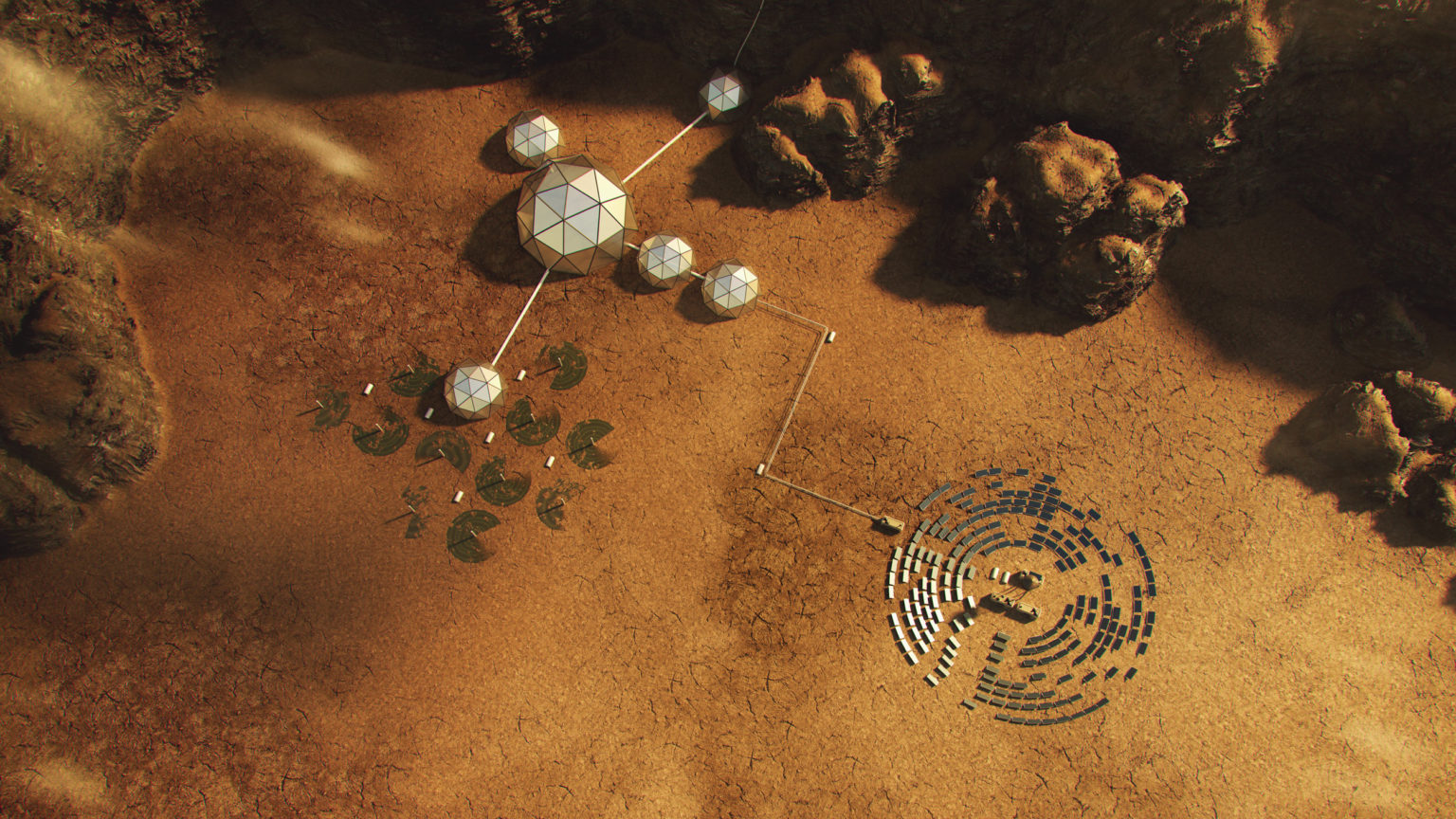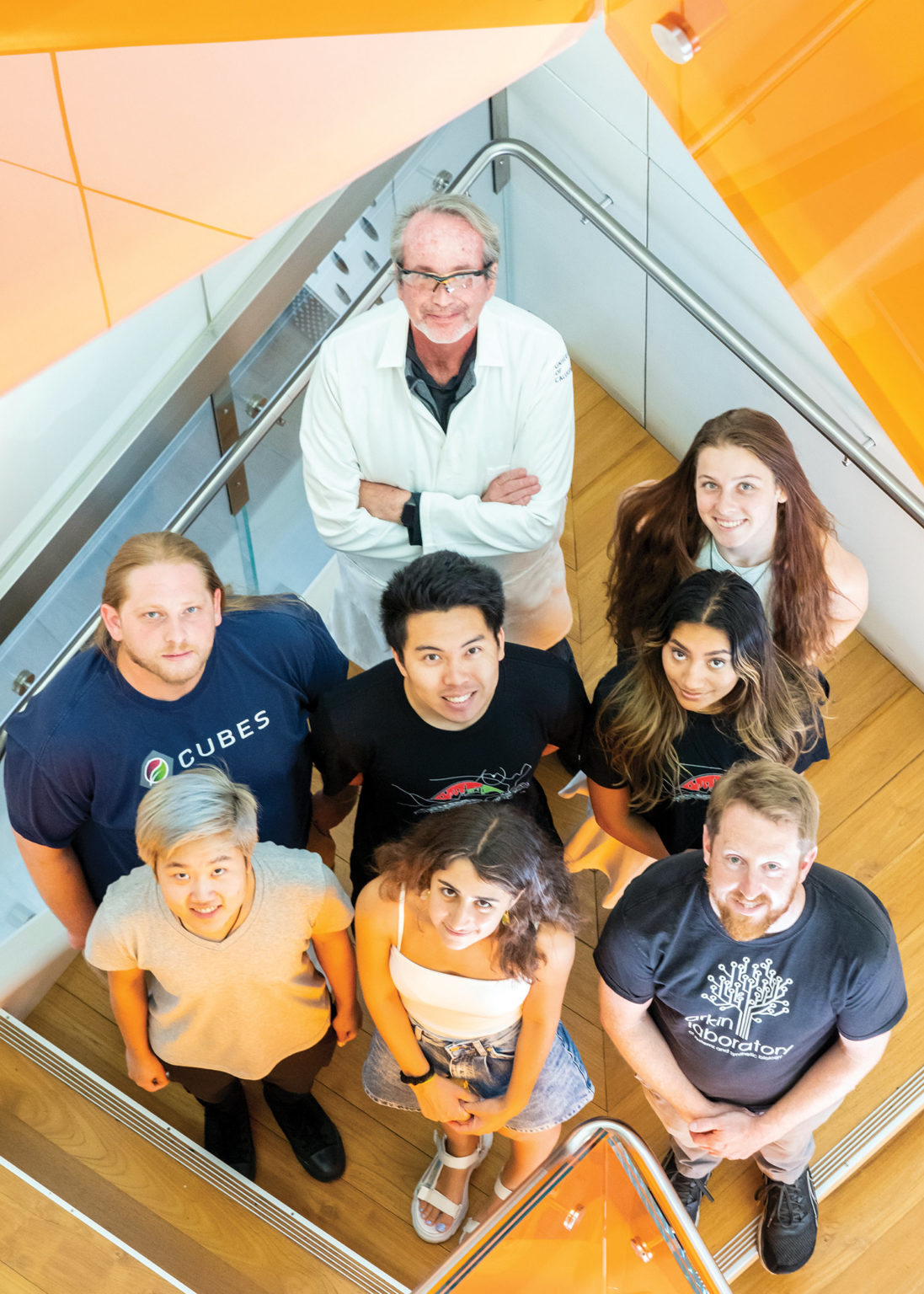Taking Up Space

Every morning at 2:30, Adam Arkin awakens from his short night’s slumber. As the rest of the neighborhood sleeps, the director of Berkeley’s Center for the Utilization of Biological Engineering in Space (CUBES) looks skyward to motivate himself for the coming day.
There, a pale red speck, millions of miles away in the cosmos, captivates his imagination and informs his work. Our presence on Mars, it turns out, is no longer the stuff of science fiction. With NASA’s successful landing of the Perseverance rover in Mars’ Jezero Crater in February 2021, the possibility of human colonization on the planet seems even more likely.
Getting there is no easy feat, and neither is sustaining life, given Mars’ limited natural resources. The uninviting environs lack oxygen and liquid water, and atmospheric temperatures are an enervating -80 degrees Fahrenheit. A lack of light makes photosynthesis — the process in which plants use light energy for growth — virtually impossible without some form of amplification.
But for national space agency officials — CUBES is a NASA Science Technology Research Institute — the once improbable has become the art of the possible. And they’ve put Arkin at the apogee of scientific inquiry.
“We want to be able to provide food, pharmaceuticals and materials for astronauts, on demand,” says Arkin, the Dean A. Richard Newton Memorial Professor of Bioengineering. “You can start out your trip with a huge truck of everything you need, but it’s expensive, and if things go wrong, you’ve lost your truck and that’s the end of it.
“We want you to take something you can grow from seed — plants, bacteria, fungi and viruses — that can start out as small frozen stocks and grow into an entire factory, so we’re designing a self-reproducing, integrated biomanufacturing system,” he adds. “Amazon doesn’t deliver this stuff. Everything has to be easy to operate and use resources hyper-efficiently and cleanly.”
For now, the researchers are working with a limited goal: supporting nine astronauts on a 12-month voyage to and back from Mars, with an intervening stay of 550 days. A mission could still be at least a decade away, according to Arkin. But the astronauts will need something akin to an extraterrestrial “starter kit” — one that not only allows for total self-sufficiency, but also uses systems that are self-sustaining, recycling everything that is used.
In the meantime, there’s a need to support humans for sustained stays in locations closer to Earth. Current efforts include NASA’s Artemis program, which foresees bases on the moon, and Blue Origin’s Orbital Reef space station. The longer humans are out there, the more resources they will need to make on site.
At CUBES, Arkin is leading efforts to create zero-waste biomanufacturing systems in “Mars-like conditions” — for travel to the planet as well as continued inhabitation. Synthetic biology, by redesigning organisms for useful purposes and engineering them to have new abilities, could be just the panacea.
“We’re concerned about the worlds that we’re going to visit, as we’re concerned about our current world,” says Arkin. “We think of this as designing sustainable manufacturing for the next planet we visit, as well as for Earth, which is rapidly transforming due to the impact of its human population.”
Worlds transformed
CUBES’ core work is in creating engineered plants and microbes to grow functional foods, medicines and materials using Mars’ typically incompatible atmospheric gases and nutrient-free substrate, the planetary surface layer known as regolith. It’s hoped that the same organisms could thrive on Earth in contaminated and otherwise marginal lands.
Further, CUBES scientists are working to create nutrient-giving plants that could grow in areas with restricted space, light, water and soil fecundity. The work also is considering biologically produced pharmaceuticals, cell-based treatments and therapeutics, and developing processes for new manufacturing technologies. Manufacturing would be done in a “closed-loop” system, in which all waste is reused and regenerated.
On Mars, manufacturing food and pharmaceuticals would involve harvesting carbon and nitrogen from the Martian atmosphere and gathering oxygen and hydrogen from frozen water sources. “From these, you fix them into molecules that can be used by other microbes and plants to grow,” Arkin says, noting that they are also using this technology to create recyclable bioplastics.
The work feeds Arkin’s innate sense of wonder. He enjoyed reading the works of Kim Stanley Robinson, whose fiction included the Mars trilogy, which imagined scientific advances made on Mars, as Earth suffered the consequences of overpopulation and ecological disaster.
“It’s about how worlds get transformed, and how technology allows us to create the world around us,” Arkin says. “I love that, the idea that we have control of and responsibility for the world, for better or for worse.”

Bioengineering professor Adam Arkin (top), postdoctoral researcher Aaron Berliner (top left) and other Arkin Lab members. (Photo by Adam Lau/Berkeley Engineering)
It’s been five years since Arkin — along with others, including Doug Clark, professor and dean at UC Berkeley’s College of Chemistry, and postdoctoral researcher Aaron Berliner — first proposed CUBES to NASA. Agency funding will continue for at least three more years.
Currently, CUBES comprises scientists from Berkeley, Stanford, UC Davis, Utah State University and the University of Florida. Researchers include Karen McDonald, a chemical engineering professor at UC Davis who is researching transgenic plants. Transgenic crops are known for their high quality and ample yield. As importantly, they also are considered “factories” for protein production necessary for making pharmaceuticals.
Specifically, McDonald and her team are creating genetically modified lettuce in which a gene-coded protein has been inserted into the plant’s genome. This can help reduce bone loss in astronauts during spaceflight. Transgenic lettuce seeds could be grown during flight, or on Mars, and the lettuce could be created to include pharmaceutical properties.
“CUBES has really motivated all of us to think outside the box, in my case making a human therapeutic and delivering it in a nontraditional way with minimal resources,” McDonald says. “Adam has been a great leader and advocate. He has a way of asking provocative questions to get the group thinking and brainstorming. It’s been a great experience.”
Other team members include the noted plant scientist Bruce Bugbee of Utah State University. He’s also working with genetically engineered plants — in his case, rice — whose photosynthetic apparatus has been modified to capture light more efficiently.
For his part, Clark, a biochemical engineer by training, is researching the potential to create reusable bioplastics from raw materials such as sugar, methane or carbon dioxide, unlike today’s unrecyclable petroleum-based plastics blamed for choking the world’s oceans and waterways. Bioplastics could be used to make whatever objects astronauts might need to lead their lives in a distant space outpost.
“The primary carbon source on Mars will be carbon dioxide,” he says. “So, using microorganisms is at least in theory the ideal solution because they’ll just continue to grow and utilize CO2 as their primary feedstock. That’s the whole premise of CUBES: to be able to use biology and biotechnology to generate the necessary materials to sustain a group of astronauts on Mars, using the limited resources that are naturally available.”
CUBES researchers are hoping that their work for Mars could also be used to address challenges on Earth, where climate change is hastening desertification, making some locations similarly inhospitable to life.
“The technologies that we’re working on developing are very relevant to the situation we find ourselves in here on Earth,” Clark says. “It’s extremely important for the future of the planet and the future of the human race.”
“Things we couldn’t do before”
In the lab, Arkin oversees several research scientists, six graduate students and 10 postdocs, including Berliner, who, like Arkin, shares a wacky circadian rhythm. While Arkin is awakening, the night owl Berliner is preparing to go to sleep. During the short overlap between sleep and wakefulness, the pair occasionally “confabulate” about their latest CUBES work, Arkin says.
Berliner is a self-proclaimed majordomo at CUBES, having earned both his doctorate in bioengineering and a master’s degree in nuclear engineering from Berkeley in 2022. He’s also an avowed “troublemaker,” touting the virtues of space and sustainability to those who don’t see the connections.
“Nowadays, in this climate in which we live, we’ve actually taken a good step toward trying to merge interest in space with an interest in sustainability,” Berliner says, adding that CUBES even coined the term “space bio process engineering,” to give the team’s efforts credibility outside laboratory walls.
“It specifically addresses a number of the United Nations sustainability grant challenges,” he says of the moniker. “The constraints of space are, in a way, inherently part of what we need to work on for constraints on Earth.”
The efforts being put forth at CUBES could pay dividends at home, leading to innovative ways to help with the looming food crisis, such as novel plant- and microbe-based foods that take fewer resources to grow and create less waste and environmental impact. The World Resources Institute reports that close to 10 billion people will inhabit Earth in 2050, adding 3 billion more mouths to feed than in 2010.
The challenge is daunting. But Arkin feels an urgent need to press on, characterizing the intensity and scope of his work as “massive.” For inspiration and clarity, he looks to the bevy of metal puzzles that populate his office.
“The puzzles seemed impossible at first, but once you see the solution, they’re simple,” he says. “You’ll see through the complexity to that very simple solution. Those puzzles give me a sense of hope — as does the skill and dedication of the teams I am part of.”
Much of Arkin’s work on behalf of Earth is looking decades ahead, when perils to the planet take on a new complexion. In 20 years, as certain regions desertify and others become wetter and more saline, scientists expect to see large changes in the quality and quantity of arable lands and potable water.
Many of the technologies developed in CUBES address more sustainable means of carbon and nitrogen fixation. This includes more resilient plants, as well as new processes for food and materials production, using plants and microbes that aren’t so land and resource intensive and that use waste-streams effectively. Some of these processes could actually be restorative to impacted environments.
“Our ability to measure and engineer organisms has been transformed even over the past two decades as our ability to read and write the DNA of plants and microbes — and predict the outcomes — has vastly improved,” Arkin says, recognizing the impact of Berkeley professor and Nobel laureate Jennifer Doudna’s pioneering work in CRISPR gene editing. “And our understanding of the interplay between environmental resources and organismal physiology and productivity has deepened enormously.”
Innovation, it is showing thus far, will be critical to solving Earth’s most pressing and existential questions. Looking beyond humankind’s tiny patch of the universe could bring transformational solutions.
“In human history, we’ve had climate change events that have led to times of plague and famine. We’ve been through things like this, but not at this rate and not at this scale. The predictions of environmental change and impact that we were making in the ’60s, based on what we were observing back then, are essentially becoming true and are moving faster than we were predicting, not slower.”
Bioengineering, Arkin says, is the ideal discipline to take on such tough challenges: “Bioengineering asks, ‘How do we harness knowledge to cause change? How do we engineer ourselves and organisms to do new things for us?’ That’s what it ultimately takes to build a human society elsewhere.”
